Kuwait's Credit Rating: Macroeconomic Factors, Bond Yields, Investors
VerifiedAdded on 2023/04/19
|11
|2345
|236
Report
AI Summary
This report critically analyzes Kuwait's credit rating based on assessments from major rating agencies like Moody's, Standard & Poor's, and Fitch. It identifies and appraises how these agencies connect overall debt levels, external debt, inflation, and other macroeconomic factors to the country's overall rating. The report also examines how the issued ratings translate into bond yields, comparing Kuwait's yields with those of countries with comparable ratings. Furthermore, it assesses the investors in Kuwait's bonds, detailing the role these bonds play in their portfolios, such as risk reduction, hedging against economic slowdowns, capital preservation, and continuous income generation through coupon payments. The analysis includes factors like per capita income, GDP growth, oil revenue, and defaulting history to provide a comprehensive overview of Kuwait's creditworthiness and its attractiveness to different types of investors.
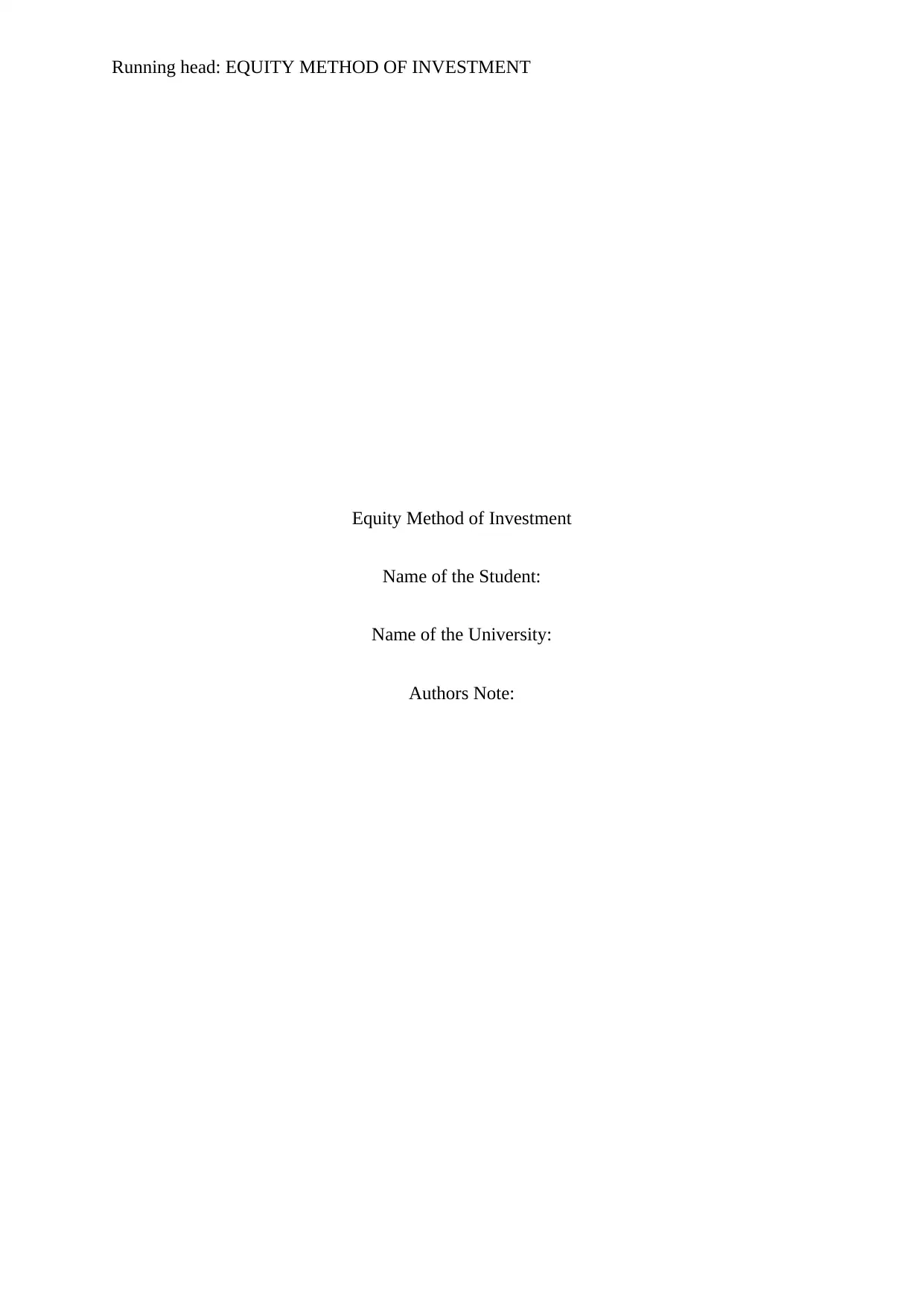
Running head: EQUITY METHOD OF INVESTMENT
Equity Method of Investment
Name of the Student:
Name of the University:
Authors Note:
Equity Method of Investment
Name of the Student:
Name of the University:
Authors Note:
Paraphrase This Document
Need a fresh take? Get an instant paraphrase of this document with our AI Paraphraser
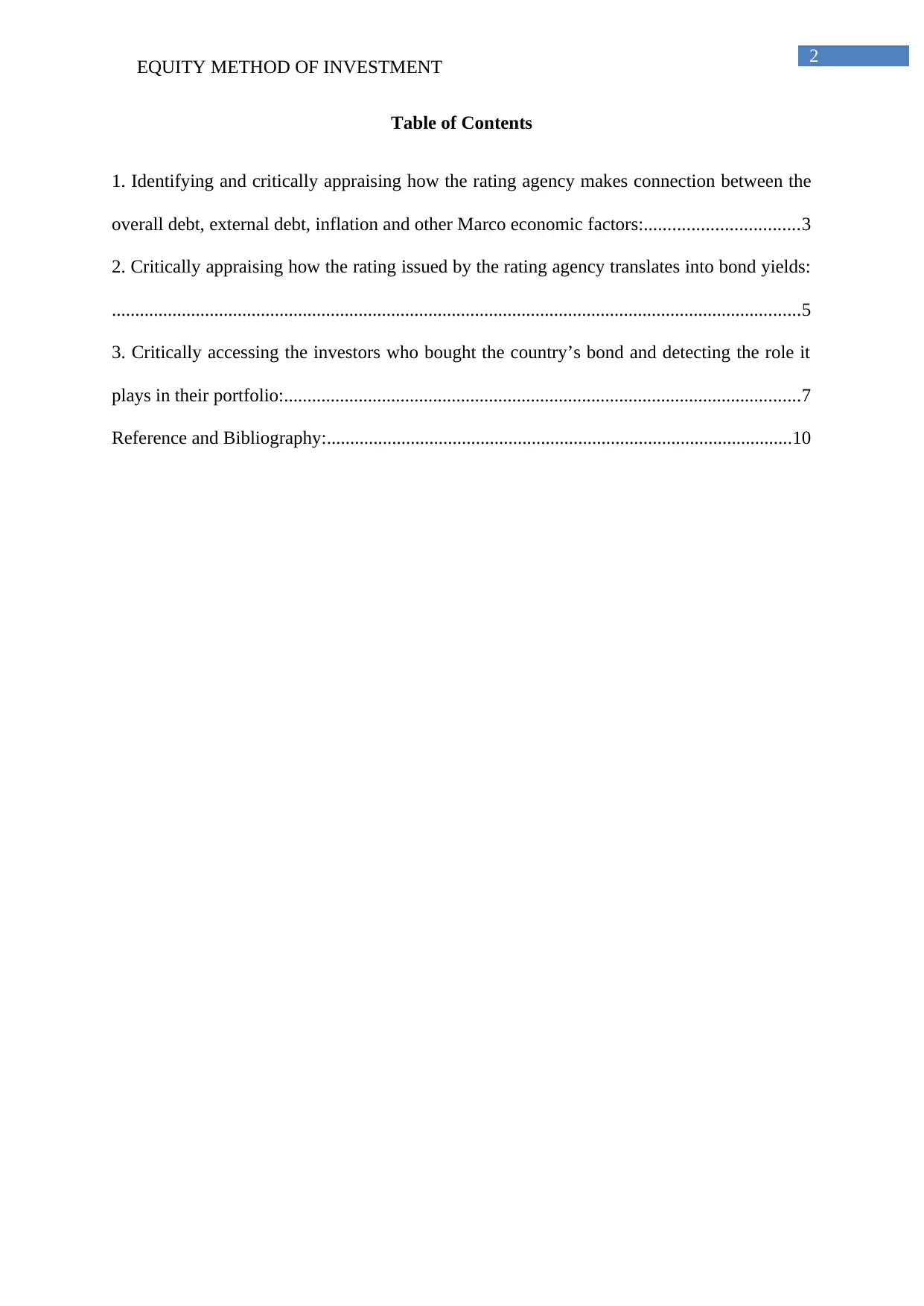
EQUITY METHOD OF INVESTMENT 2
Table of Contents
1. Identifying and critically appraising how the rating agency makes connection between the
overall debt, external debt, inflation and other Marco economic factors:.................................3
2. Critically appraising how the rating issued by the rating agency translates into bond yields:
....................................................................................................................................................5
3. Critically accessing the investors who bought the country’s bond and detecting the role it
plays in their portfolio:...............................................................................................................7
Reference and Bibliography:....................................................................................................10
Table of Contents
1. Identifying and critically appraising how the rating agency makes connection between the
overall debt, external debt, inflation and other Marco economic factors:.................................3
2. Critically appraising how the rating issued by the rating agency translates into bond yields:
....................................................................................................................................................5
3. Critically accessing the investors who bought the country’s bond and detecting the role it
plays in their portfolio:...............................................................................................................7
Reference and Bibliography:....................................................................................................10
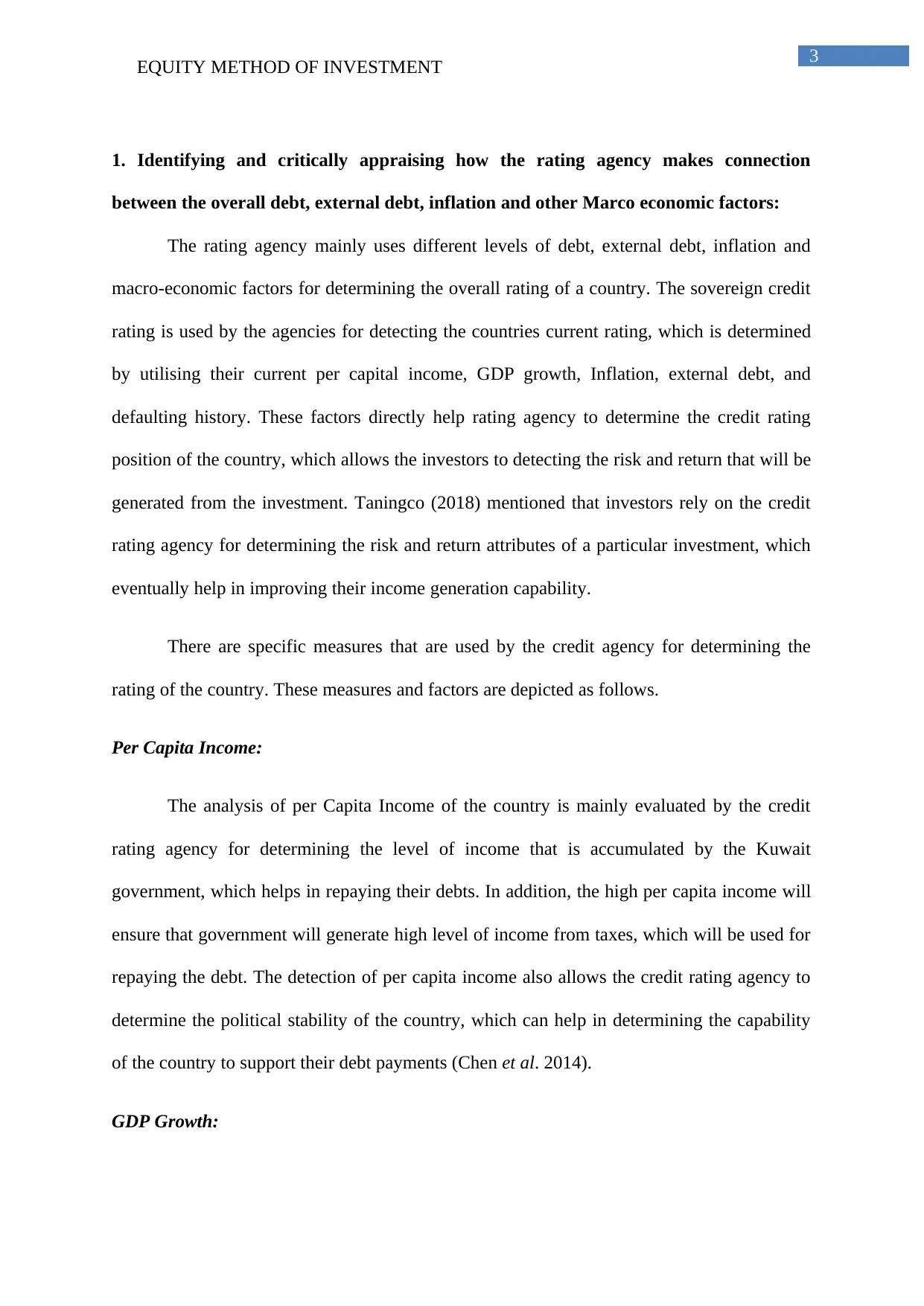
EQUITY METHOD OF INVESTMENT 3
1. Identifying and critically appraising how the rating agency makes connection
between the overall debt, external debt, inflation and other Marco economic factors:
The rating agency mainly uses different levels of debt, external debt, inflation and
macro-economic factors for determining the overall rating of a country. The sovereign credit
rating is used by the agencies for detecting the countries current rating, which is determined
by utilising their current per capital income, GDP growth, Inflation, external debt, and
defaulting history. These factors directly help rating agency to determine the credit rating
position of the country, which allows the investors to detecting the risk and return that will be
generated from the investment. Taningco (2018) mentioned that investors rely on the credit
rating agency for determining the risk and return attributes of a particular investment, which
eventually help in improving their income generation capability.
There are specific measures that are used by the credit agency for determining the
rating of the country. These measures and factors are depicted as follows.
Per Capita Income:
The analysis of per Capita Income of the country is mainly evaluated by the credit
rating agency for determining the level of income that is accumulated by the Kuwait
government, which helps in repaying their debts. In addition, the high per capita income will
ensure that government will generate high level of income from taxes, which will be used for
repaying the debt. The detection of per capita income also allows the credit rating agency to
determine the political stability of the country, which can help in determining the capability
of the country to support their debt payments (Chen et al. 2014).
GDP Growth:
1. Identifying and critically appraising how the rating agency makes connection
between the overall debt, external debt, inflation and other Marco economic factors:
The rating agency mainly uses different levels of debt, external debt, inflation and
macro-economic factors for determining the overall rating of a country. The sovereign credit
rating is used by the agencies for detecting the countries current rating, which is determined
by utilising their current per capital income, GDP growth, Inflation, external debt, and
defaulting history. These factors directly help rating agency to determine the credit rating
position of the country, which allows the investors to detecting the risk and return that will be
generated from the investment. Taningco (2018) mentioned that investors rely on the credit
rating agency for determining the risk and return attributes of a particular investment, which
eventually help in improving their income generation capability.
There are specific measures that are used by the credit agency for determining the
rating of the country. These measures and factors are depicted as follows.
Per Capita Income:
The analysis of per Capita Income of the country is mainly evaluated by the credit
rating agency for determining the level of income that is accumulated by the Kuwait
government, which helps in repaying their debts. In addition, the high per capita income will
ensure that government will generate high level of income from taxes, which will be used for
repaying the debt. The detection of per capita income also allows the credit rating agency to
determine the political stability of the country, which can help in determining the capability
of the country to support their debt payments (Chen et al. 2014).
GDP Growth:
⊘ This is a preview!⊘
Do you want full access?
Subscribe today to unlock all pages.

Trusted by 1+ million students worldwide
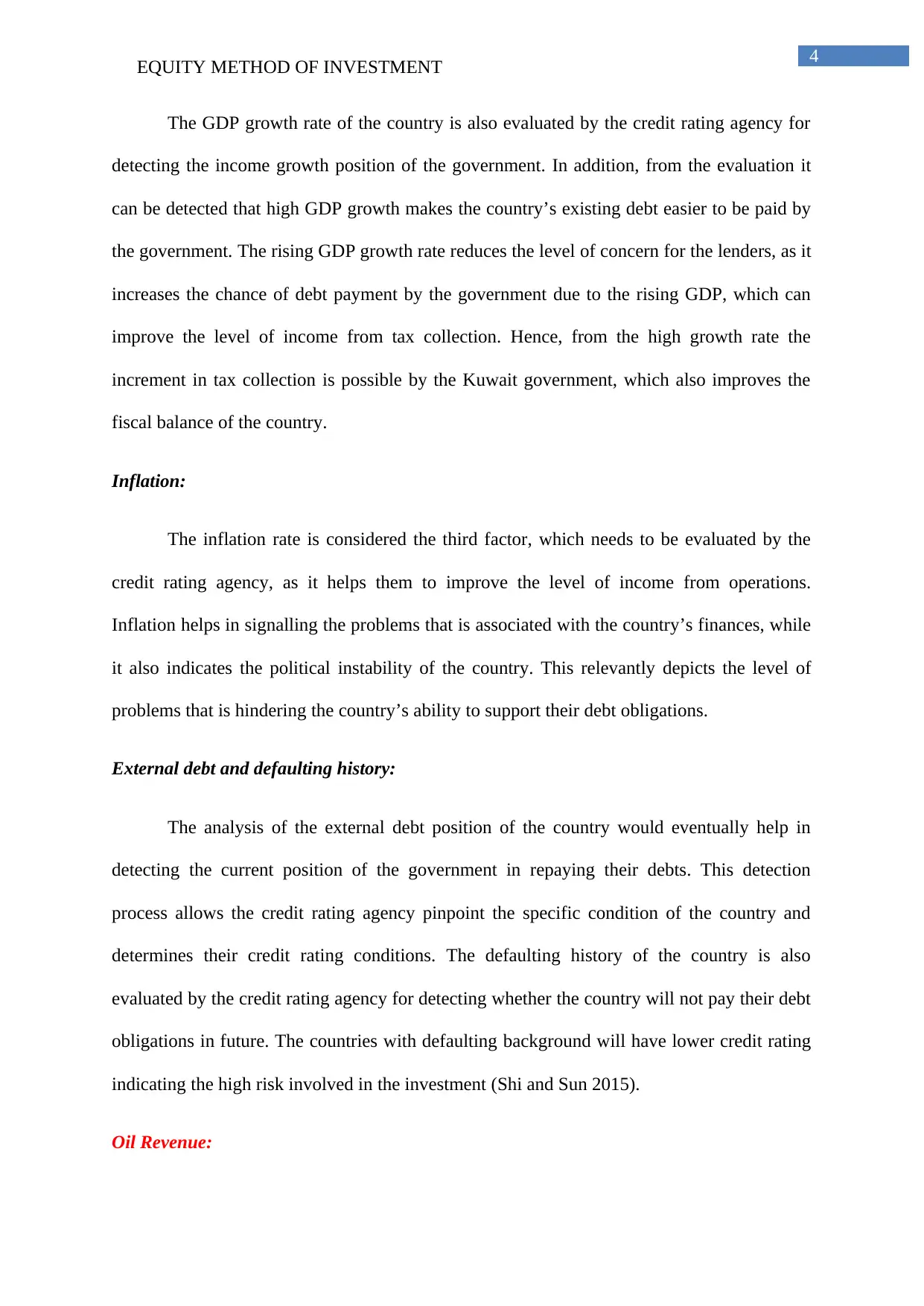
EQUITY METHOD OF INVESTMENT 4
The GDP growth rate of the country is also evaluated by the credit rating agency for
detecting the income growth position of the government. In addition, from the evaluation it
can be detected that high GDP growth makes the country’s existing debt easier to be paid by
the government. The rising GDP growth rate reduces the level of concern for the lenders, as it
increases the chance of debt payment by the government due to the rising GDP, which can
improve the level of income from tax collection. Hence, from the high growth rate the
increment in tax collection is possible by the Kuwait government, which also improves the
fiscal balance of the country.
Inflation:
The inflation rate is considered the third factor, which needs to be evaluated by the
credit rating agency, as it helps them to improve the level of income from operations.
Inflation helps in signalling the problems that is associated with the country’s finances, while
it also indicates the political instability of the country. This relevantly depicts the level of
problems that is hindering the country’s ability to support their debt obligations.
External debt and defaulting history:
The analysis of the external debt position of the country would eventually help in
detecting the current position of the government in repaying their debts. This detection
process allows the credit rating agency pinpoint the specific condition of the country and
determines their credit rating conditions. The defaulting history of the country is also
evaluated by the credit rating agency for detecting whether the country will not pay their debt
obligations in future. The countries with defaulting background will have lower credit rating
indicating the high risk involved in the investment (Shi and Sun 2015).
Oil Revenue:
The GDP growth rate of the country is also evaluated by the credit rating agency for
detecting the income growth position of the government. In addition, from the evaluation it
can be detected that high GDP growth makes the country’s existing debt easier to be paid by
the government. The rising GDP growth rate reduces the level of concern for the lenders, as it
increases the chance of debt payment by the government due to the rising GDP, which can
improve the level of income from tax collection. Hence, from the high growth rate the
increment in tax collection is possible by the Kuwait government, which also improves the
fiscal balance of the country.
Inflation:
The inflation rate is considered the third factor, which needs to be evaluated by the
credit rating agency, as it helps them to improve the level of income from operations.
Inflation helps in signalling the problems that is associated with the country’s finances, while
it also indicates the political instability of the country. This relevantly depicts the level of
problems that is hindering the country’s ability to support their debt obligations.
External debt and defaulting history:
The analysis of the external debt position of the country would eventually help in
detecting the current position of the government in repaying their debts. This detection
process allows the credit rating agency pinpoint the specific condition of the country and
determines their credit rating conditions. The defaulting history of the country is also
evaluated by the credit rating agency for detecting whether the country will not pay their debt
obligations in future. The countries with defaulting background will have lower credit rating
indicating the high risk involved in the investment (Shi and Sun 2015).
Oil Revenue:
Paraphrase This Document
Need a fresh take? Get an instant paraphrase of this document with our AI Paraphraser
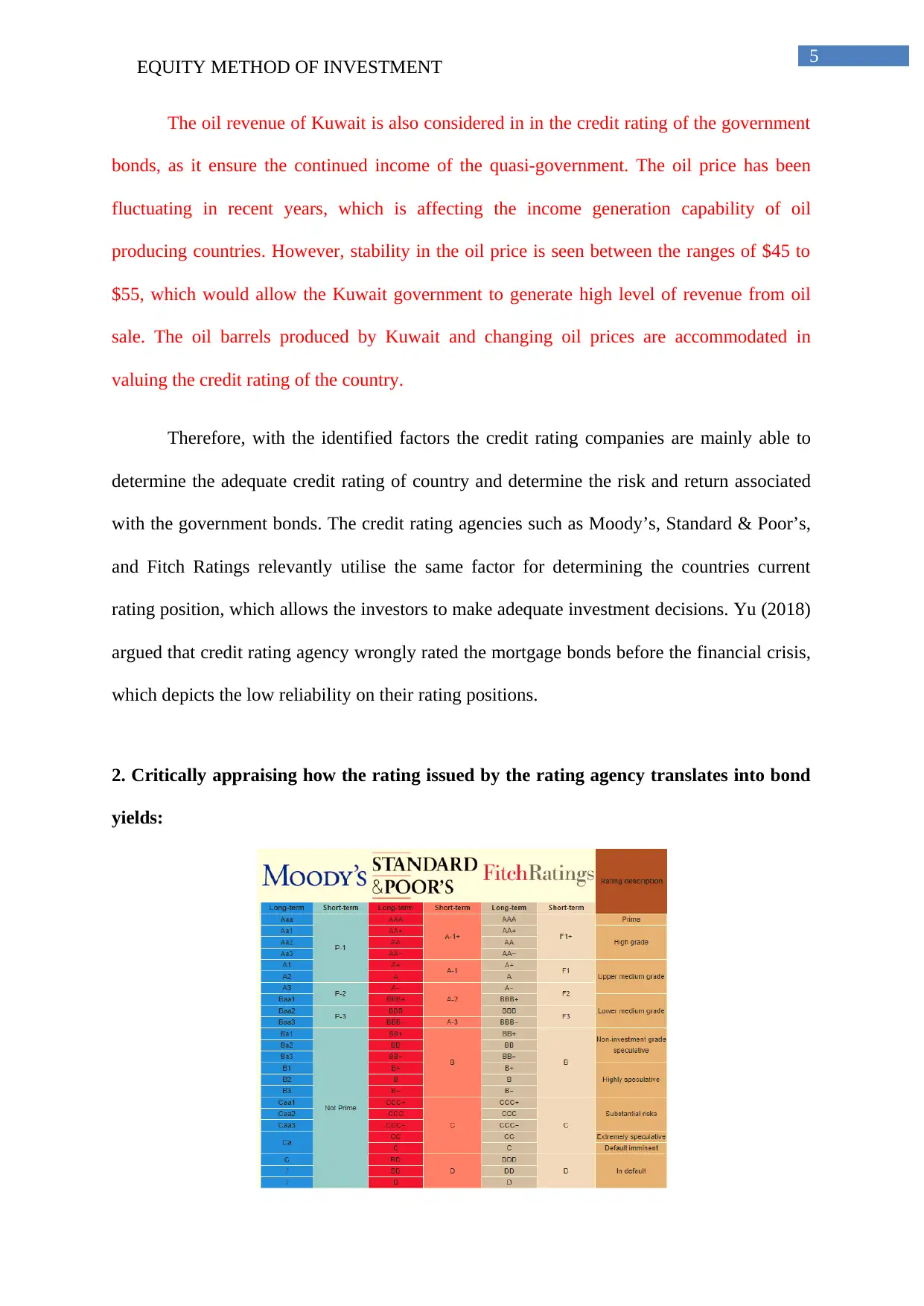
EQUITY METHOD OF INVESTMENT 5
The oil revenue of Kuwait is also considered in in the credit rating of the government
bonds, as it ensure the continued income of the quasi-government. The oil price has been
fluctuating in recent years, which is affecting the income generation capability of oil
producing countries. However, stability in the oil price is seen between the ranges of $45 to
$55, which would allow the Kuwait government to generate high level of revenue from oil
sale. The oil barrels produced by Kuwait and changing oil prices are accommodated in
valuing the credit rating of the country.
Therefore, with the identified factors the credit rating companies are mainly able to
determine the adequate credit rating of country and determine the risk and return associated
with the government bonds. The credit rating agencies such as Moody’s, Standard & Poor’s,
and Fitch Ratings relevantly utilise the same factor for determining the countries current
rating position, which allows the investors to make adequate investment decisions. Yu (2018)
argued that credit rating agency wrongly rated the mortgage bonds before the financial crisis,
which depicts the low reliability on their rating positions.
2. Critically appraising how the rating issued by the rating agency translates into bond
yields:
The oil revenue of Kuwait is also considered in in the credit rating of the government
bonds, as it ensure the continued income of the quasi-government. The oil price has been
fluctuating in recent years, which is affecting the income generation capability of oil
producing countries. However, stability in the oil price is seen between the ranges of $45 to
$55, which would allow the Kuwait government to generate high level of revenue from oil
sale. The oil barrels produced by Kuwait and changing oil prices are accommodated in
valuing the credit rating of the country.
Therefore, with the identified factors the credit rating companies are mainly able to
determine the adequate credit rating of country and determine the risk and return associated
with the government bonds. The credit rating agencies such as Moody’s, Standard & Poor’s,
and Fitch Ratings relevantly utilise the same factor for determining the countries current
rating position, which allows the investors to make adequate investment decisions. Yu (2018)
argued that credit rating agency wrongly rated the mortgage bonds before the financial crisis,
which depicts the low reliability on their rating positions.
2. Critically appraising how the rating issued by the rating agency translates into bond
yields:
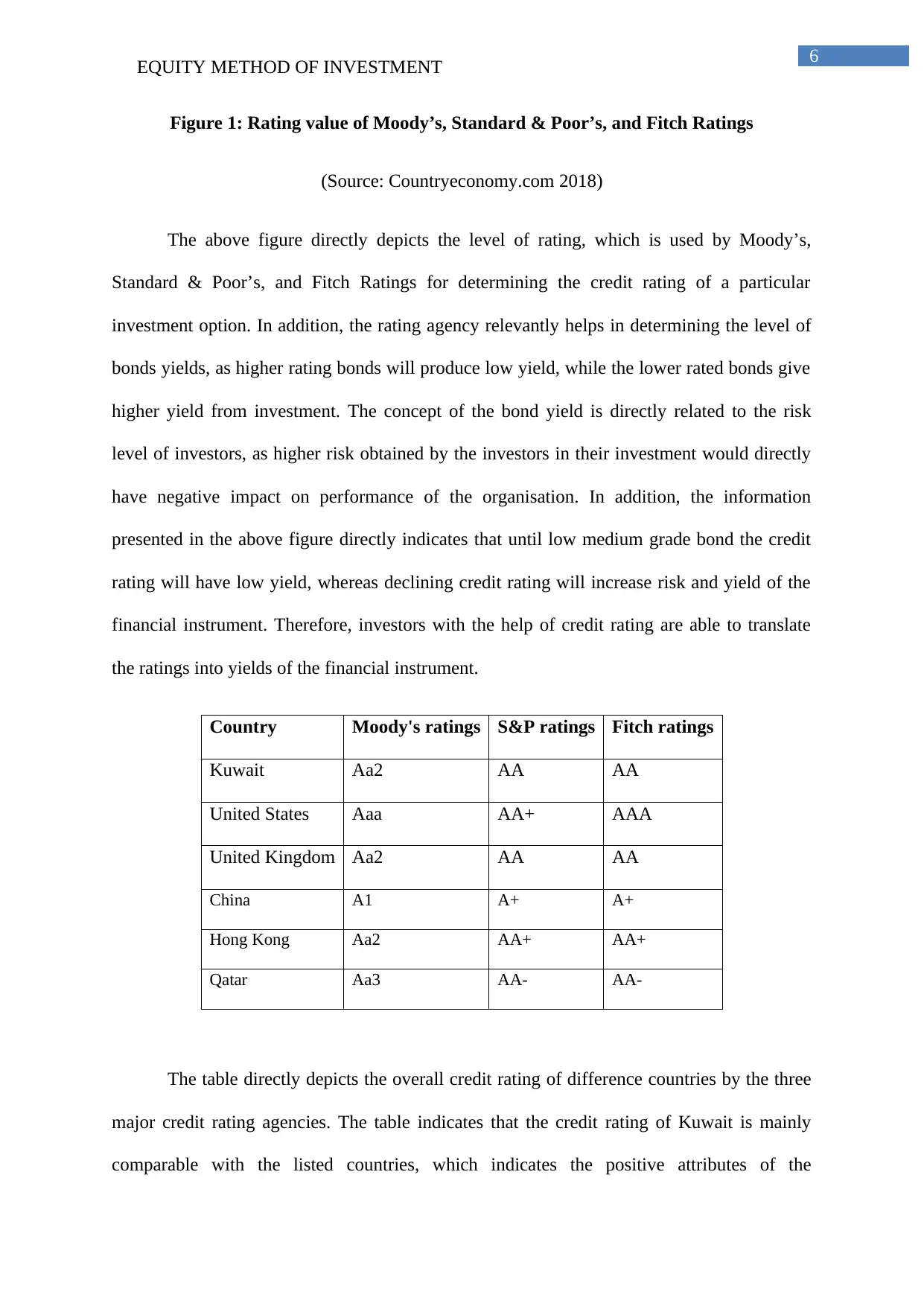
EQUITY METHOD OF INVESTMENT 6
Figure 1: Rating value of Moody’s, Standard & Poor’s, and Fitch Ratings
(Source: Countryeconomy.com 2018)
The above figure directly depicts the level of rating, which is used by Moody’s,
Standard & Poor’s, and Fitch Ratings for determining the credit rating of a particular
investment option. In addition, the rating agency relevantly helps in determining the level of
bonds yields, as higher rating bonds will produce low yield, while the lower rated bonds give
higher yield from investment. The concept of the bond yield is directly related to the risk
level of investors, as higher risk obtained by the investors in their investment would directly
have negative impact on performance of the organisation. In addition, the information
presented in the above figure directly indicates that until low medium grade bond the credit
rating will have low yield, whereas declining credit rating will increase risk and yield of the
financial instrument. Therefore, investors with the help of credit rating are able to translate
the ratings into yields of the financial instrument.
Country Moody's ratings S&P ratings Fitch ratings
Kuwait Aa2 AA AA
United States Aaa AA+ AAA
United Kingdom Aa2 AA AA
China A1 A+ A+
Hong Kong Aa2 AA+ AA+
Qatar Aa3 AA- AA-
The table directly depicts the overall credit rating of difference countries by the three
major credit rating agencies. The table indicates that the credit rating of Kuwait is mainly
comparable with the listed countries, which indicates the positive attributes of the
Figure 1: Rating value of Moody’s, Standard & Poor’s, and Fitch Ratings
(Source: Countryeconomy.com 2018)
The above figure directly depicts the level of rating, which is used by Moody’s,
Standard & Poor’s, and Fitch Ratings for determining the credit rating of a particular
investment option. In addition, the rating agency relevantly helps in determining the level of
bonds yields, as higher rating bonds will produce low yield, while the lower rated bonds give
higher yield from investment. The concept of the bond yield is directly related to the risk
level of investors, as higher risk obtained by the investors in their investment would directly
have negative impact on performance of the organisation. In addition, the information
presented in the above figure directly indicates that until low medium grade bond the credit
rating will have low yield, whereas declining credit rating will increase risk and yield of the
financial instrument. Therefore, investors with the help of credit rating are able to translate
the ratings into yields of the financial instrument.
Country Moody's ratings S&P ratings Fitch ratings
Kuwait Aa2 AA AA
United States Aaa AA+ AAA
United Kingdom Aa2 AA AA
China A1 A+ A+
Hong Kong Aa2 AA+ AA+
Qatar Aa3 AA- AA-
The table directly depicts the overall credit rating of difference countries by the three
major credit rating agencies. The table indicates that the credit rating of Kuwait is mainly
comparable with the listed countries, which indicates the positive attributes of the
⊘ This is a preview!⊘
Do you want full access?
Subscribe today to unlock all pages.

Trusted by 1+ million students worldwide
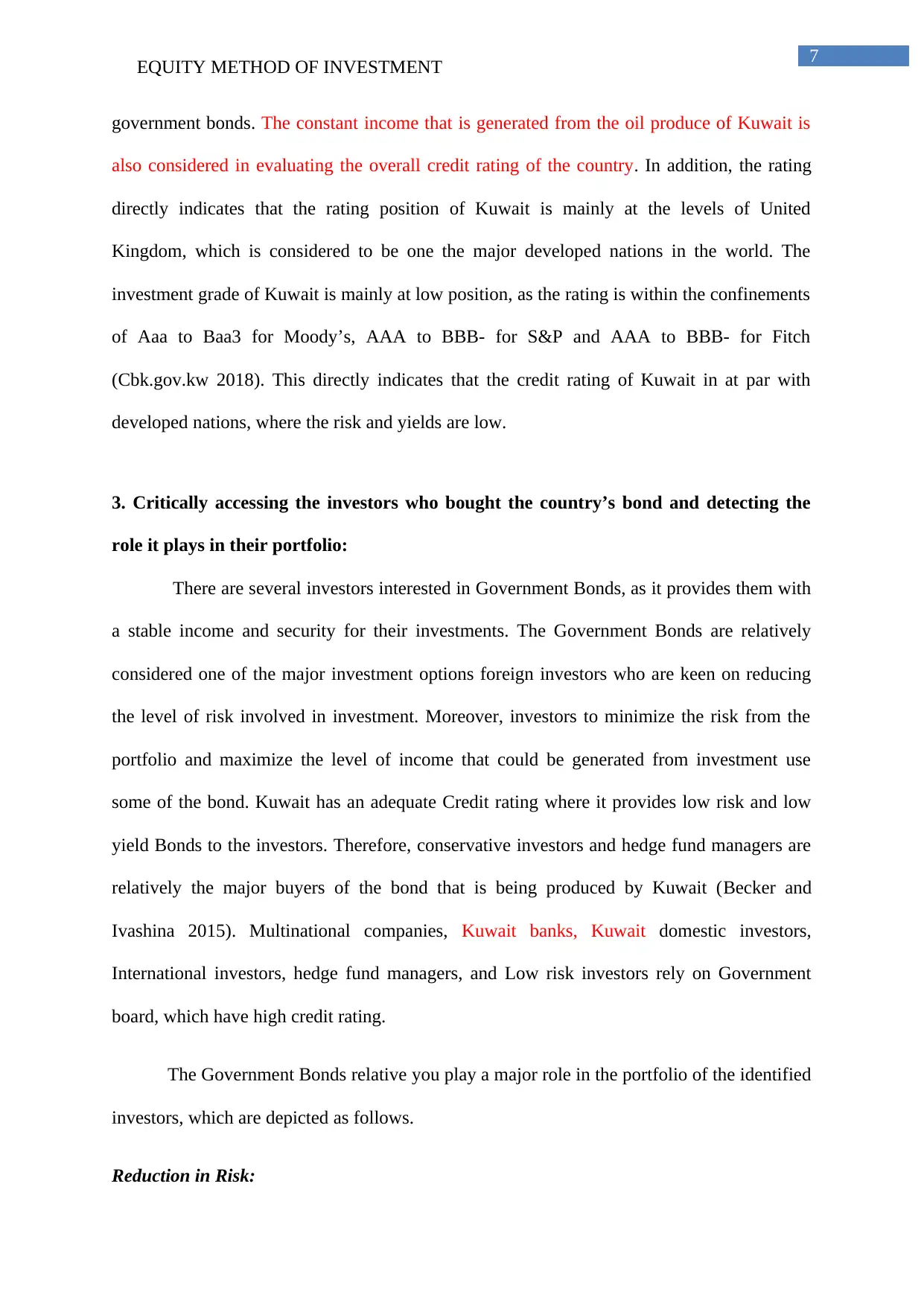
EQUITY METHOD OF INVESTMENT 7
government bonds. The constant income that is generated from the oil produce of Kuwait is
also considered in evaluating the overall credit rating of the country. In addition, the rating
directly indicates that the rating position of Kuwait is mainly at the levels of United
Kingdom, which is considered to be one the major developed nations in the world. The
investment grade of Kuwait is mainly at low position, as the rating is within the confinements
of Aaa to Baa3 for Moody’s, AAA to BBB- for S&P and AAA to BBB- for Fitch
(Cbk.gov.kw 2018). This directly indicates that the credit rating of Kuwait in at par with
developed nations, where the risk and yields are low.
3. Critically accessing the investors who bought the country’s bond and detecting the
role it plays in their portfolio:
There are several investors interested in Government Bonds, as it provides them with
a stable income and security for their investments. The Government Bonds are relatively
considered one of the major investment options foreign investors who are keen on reducing
the level of risk involved in investment. Moreover, investors to minimize the risk from the
portfolio and maximize the level of income that could be generated from investment use
some of the bond. Kuwait has an adequate Credit rating where it provides low risk and low
yield Bonds to the investors. Therefore, conservative investors and hedge fund managers are
relatively the major buyers of the bond that is being produced by Kuwait (Becker and
Ivashina 2015). Multinational companies, Kuwait banks, Kuwait domestic investors,
International investors, hedge fund managers, and Low risk investors rely on Government
board, which have high credit rating.
The Government Bonds relative you play a major role in the portfolio of the identified
investors, which are depicted as follows.
Reduction in Risk:
government bonds. The constant income that is generated from the oil produce of Kuwait is
also considered in evaluating the overall credit rating of the country. In addition, the rating
directly indicates that the rating position of Kuwait is mainly at the levels of United
Kingdom, which is considered to be one the major developed nations in the world. The
investment grade of Kuwait is mainly at low position, as the rating is within the confinements
of Aaa to Baa3 for Moody’s, AAA to BBB- for S&P and AAA to BBB- for Fitch
(Cbk.gov.kw 2018). This directly indicates that the credit rating of Kuwait in at par with
developed nations, where the risk and yields are low.
3. Critically accessing the investors who bought the country’s bond and detecting the
role it plays in their portfolio:
There are several investors interested in Government Bonds, as it provides them with
a stable income and security for their investments. The Government Bonds are relatively
considered one of the major investment options foreign investors who are keen on reducing
the level of risk involved in investment. Moreover, investors to minimize the risk from the
portfolio and maximize the level of income that could be generated from investment use
some of the bond. Kuwait has an adequate Credit rating where it provides low risk and low
yield Bonds to the investors. Therefore, conservative investors and hedge fund managers are
relatively the major buyers of the bond that is being produced by Kuwait (Becker and
Ivashina 2015). Multinational companies, Kuwait banks, Kuwait domestic investors,
International investors, hedge fund managers, and Low risk investors rely on Government
board, which have high credit rating.
The Government Bonds relative you play a major role in the portfolio of the identified
investors, which are depicted as follows.
Reduction in Risk:
Paraphrase This Document
Need a fresh take? Get an instant paraphrase of this document with our AI Paraphraser
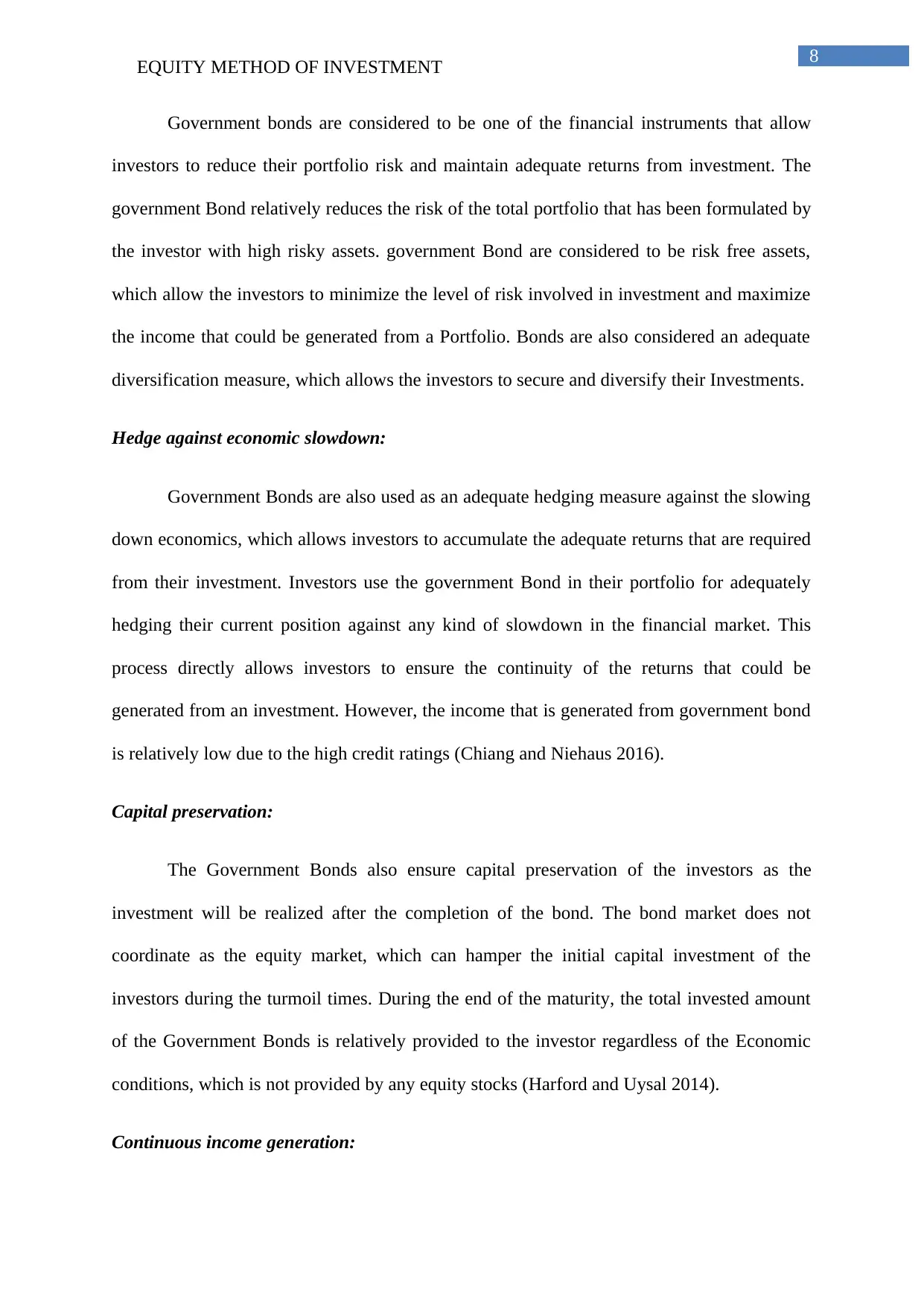
EQUITY METHOD OF INVESTMENT 8
Government bonds are considered to be one of the financial instruments that allow
investors to reduce their portfolio risk and maintain adequate returns from investment. The
government Bond relatively reduces the risk of the total portfolio that has been formulated by
the investor with high risky assets. government Bond are considered to be risk free assets,
which allow the investors to minimize the level of risk involved in investment and maximize
the income that could be generated from a Portfolio. Bonds are also considered an adequate
diversification measure, which allows the investors to secure and diversify their Investments.
Hedge against economic slowdown:
Government Bonds are also used as an adequate hedging measure against the slowing
down economics, which allows investors to accumulate the adequate returns that are required
from their investment. Investors use the government Bond in their portfolio for adequately
hedging their current position against any kind of slowdown in the financial market. This
process directly allows investors to ensure the continuity of the returns that could be
generated from an investment. However, the income that is generated from government bond
is relatively low due to the high credit ratings (Chiang and Niehaus 2016).
Capital preservation:
The Government Bonds also ensure capital preservation of the investors as the
investment will be realized after the completion of the bond. The bond market does not
coordinate as the equity market, which can hamper the initial capital investment of the
investors during the turmoil times. During the end of the maturity, the total invested amount
of the Government Bonds is relatively provided to the investor regardless of the Economic
conditions, which is not provided by any equity stocks (Harford and Uysal 2014).
Continuous income generation:
Government bonds are considered to be one of the financial instruments that allow
investors to reduce their portfolio risk and maintain adequate returns from investment. The
government Bond relatively reduces the risk of the total portfolio that has been formulated by
the investor with high risky assets. government Bond are considered to be risk free assets,
which allow the investors to minimize the level of risk involved in investment and maximize
the income that could be generated from a Portfolio. Bonds are also considered an adequate
diversification measure, which allows the investors to secure and diversify their Investments.
Hedge against economic slowdown:
Government Bonds are also used as an adequate hedging measure against the slowing
down economics, which allows investors to accumulate the adequate returns that are required
from their investment. Investors use the government Bond in their portfolio for adequately
hedging their current position against any kind of slowdown in the financial market. This
process directly allows investors to ensure the continuity of the returns that could be
generated from an investment. However, the income that is generated from government bond
is relatively low due to the high credit ratings (Chiang and Niehaus 2016).
Capital preservation:
The Government Bonds also ensure capital preservation of the investors as the
investment will be realized after the completion of the bond. The bond market does not
coordinate as the equity market, which can hamper the initial capital investment of the
investors during the turmoil times. During the end of the maturity, the total invested amount
of the Government Bonds is relatively provided to the investor regardless of the Economic
conditions, which is not provided by any equity stocks (Harford and Uysal 2014).
Continuous income generation:
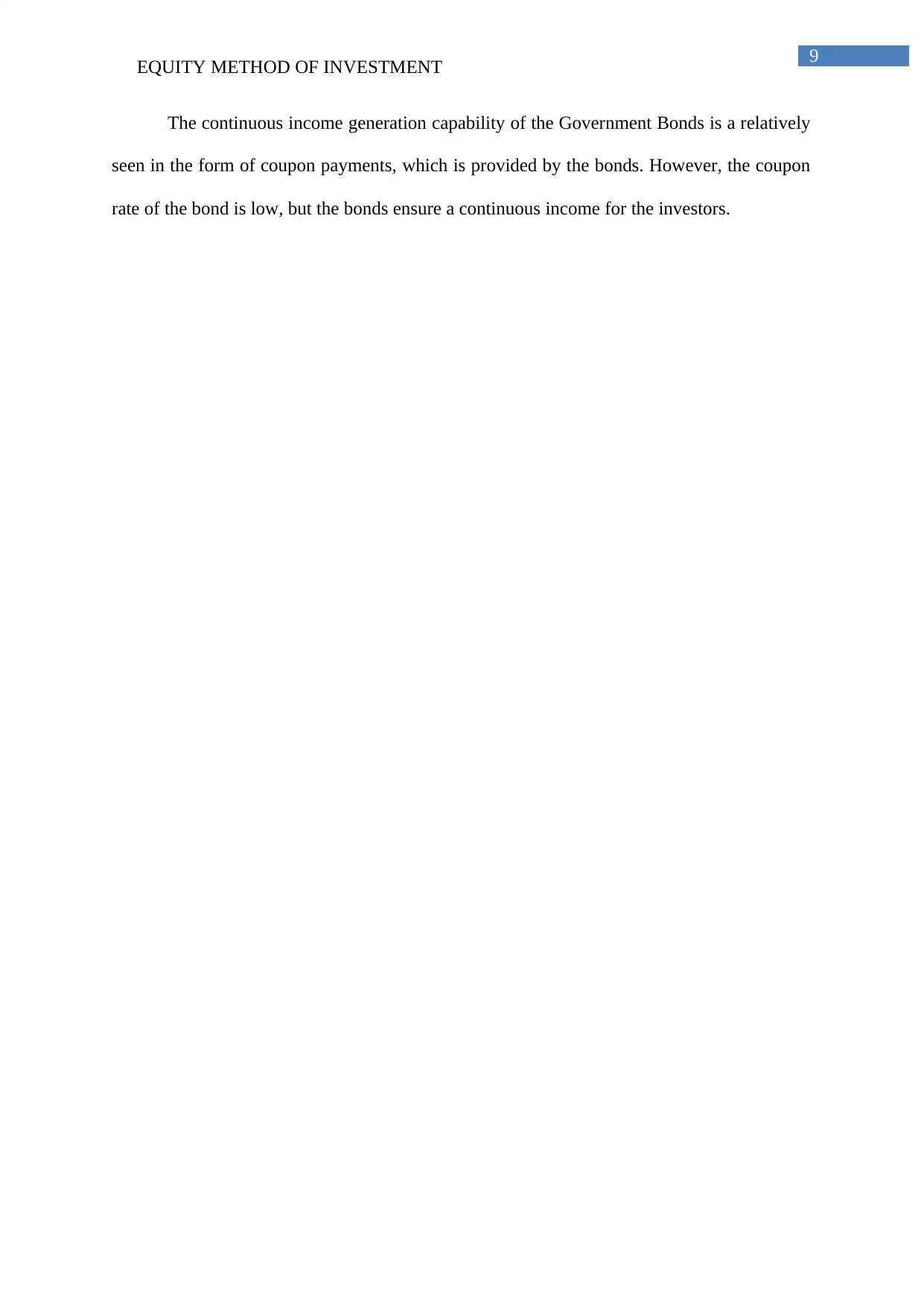
EQUITY METHOD OF INVESTMENT 9
The continuous income generation capability of the Government Bonds is a relatively
seen in the form of coupon payments, which is provided by the bonds. However, the coupon
rate of the bond is low, but the bonds ensure a continuous income for the investors.
The continuous income generation capability of the Government Bonds is a relatively
seen in the form of coupon payments, which is provided by the bonds. However, the coupon
rate of the bond is low, but the bonds ensure a continuous income for the investors.
⊘ This is a preview!⊘
Do you want full access?
Subscribe today to unlock all pages.

Trusted by 1+ million students worldwide
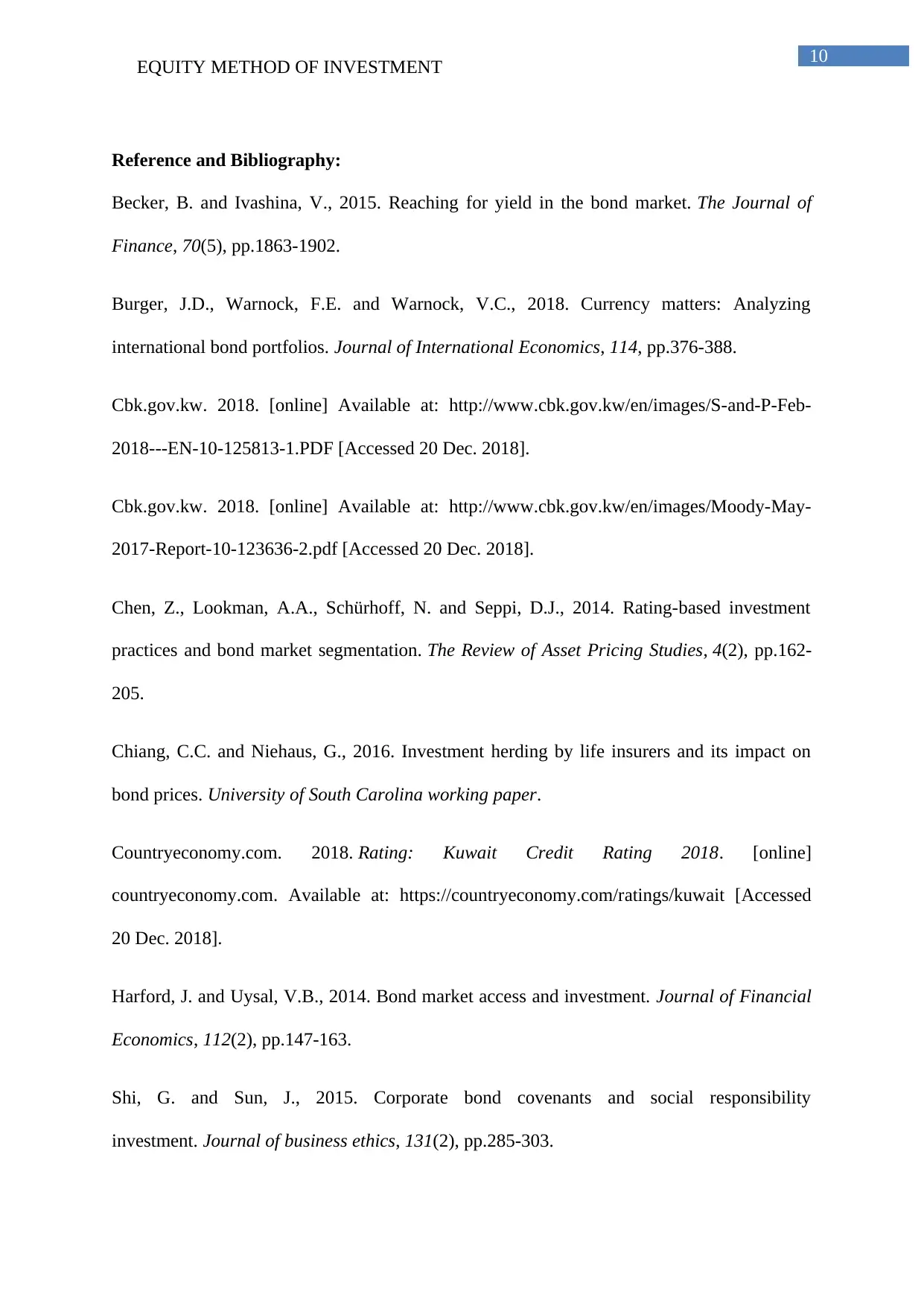
EQUITY METHOD OF INVESTMENT 10
Reference and Bibliography:
Becker, B. and Ivashina, V., 2015. Reaching for yield in the bond market. The Journal of
Finance, 70(5), pp.1863-1902.
Burger, J.D., Warnock, F.E. and Warnock, V.C., 2018. Currency matters: Analyzing
international bond portfolios. Journal of International Economics, 114, pp.376-388.
Cbk.gov.kw. 2018. [online] Available at: http://www.cbk.gov.kw/en/images/S-and-P-Feb-
2018---EN-10-125813-1.PDF [Accessed 20 Dec. 2018].
Cbk.gov.kw. 2018. [online] Available at: http://www.cbk.gov.kw/en/images/Moody-May-
2017-Report-10-123636-2.pdf [Accessed 20 Dec. 2018].
Chen, Z., Lookman, A.A., Schürhoff, N. and Seppi, D.J., 2014. Rating-based investment
practices and bond market segmentation. The Review of Asset Pricing Studies, 4(2), pp.162-
205.
Chiang, C.C. and Niehaus, G., 2016. Investment herding by life insurers and its impact on
bond prices. University of South Carolina working paper.
Countryeconomy.com. 2018. Rating: Kuwait Credit Rating 2018. [online]
countryeconomy.com. Available at: https://countryeconomy.com/ratings/kuwait [Accessed
20 Dec. 2018].
Harford, J. and Uysal, V.B., 2014. Bond market access and investment. Journal of Financial
Economics, 112(2), pp.147-163.
Shi, G. and Sun, J., 2015. Corporate bond covenants and social responsibility
investment. Journal of business ethics, 131(2), pp.285-303.
Reference and Bibliography:
Becker, B. and Ivashina, V., 2015. Reaching for yield in the bond market. The Journal of
Finance, 70(5), pp.1863-1902.
Burger, J.D., Warnock, F.E. and Warnock, V.C., 2018. Currency matters: Analyzing
international bond portfolios. Journal of International Economics, 114, pp.376-388.
Cbk.gov.kw. 2018. [online] Available at: http://www.cbk.gov.kw/en/images/S-and-P-Feb-
2018---EN-10-125813-1.PDF [Accessed 20 Dec. 2018].
Cbk.gov.kw. 2018. [online] Available at: http://www.cbk.gov.kw/en/images/Moody-May-
2017-Report-10-123636-2.pdf [Accessed 20 Dec. 2018].
Chen, Z., Lookman, A.A., Schürhoff, N. and Seppi, D.J., 2014. Rating-based investment
practices and bond market segmentation. The Review of Asset Pricing Studies, 4(2), pp.162-
205.
Chiang, C.C. and Niehaus, G., 2016. Investment herding by life insurers and its impact on
bond prices. University of South Carolina working paper.
Countryeconomy.com. 2018. Rating: Kuwait Credit Rating 2018. [online]
countryeconomy.com. Available at: https://countryeconomy.com/ratings/kuwait [Accessed
20 Dec. 2018].
Harford, J. and Uysal, V.B., 2014. Bond market access and investment. Journal of Financial
Economics, 112(2), pp.147-163.
Shi, G. and Sun, J., 2015. Corporate bond covenants and social responsibility
investment. Journal of business ethics, 131(2), pp.285-303.
Paraphrase This Document
Need a fresh take? Get an instant paraphrase of this document with our AI Paraphraser
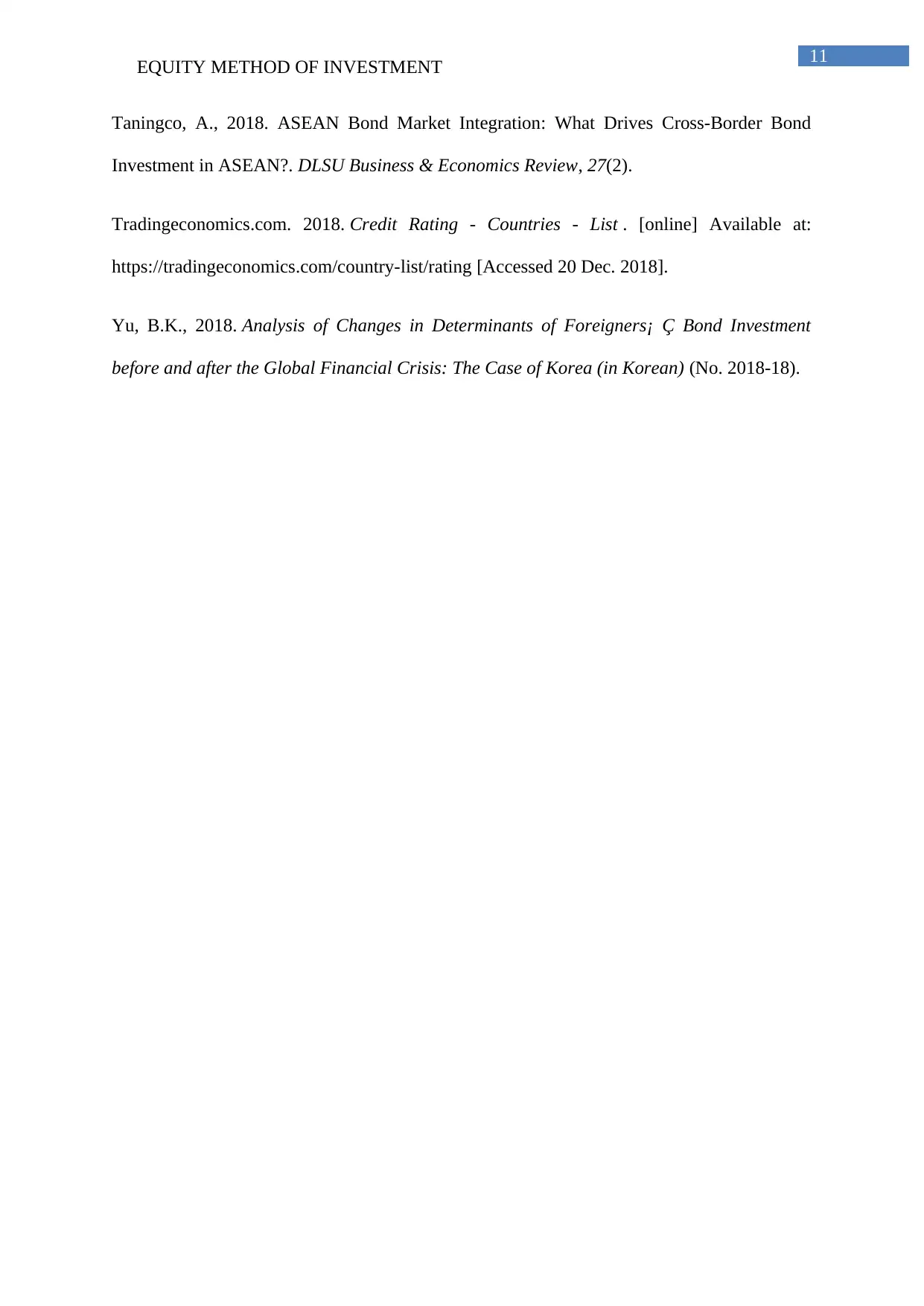
EQUITY METHOD OF INVESTMENT 11
Taningco, A., 2018. ASEAN Bond Market Integration: What Drives Cross-Border Bond
Investment in ASEAN?. DLSU Business & Economics Review, 27(2).
Tradingeconomics.com. 2018. Credit Rating - Countries - List . [online] Available at:
https://tradingeconomics.com/country-list/rating [Accessed 20 Dec. 2018].
Yu, B.K., 2018. Analysis of Changes in Determinants of Foreigners¡ Ç Bond Investment
before and after the Global Financial Crisis: The Case of Korea (in Korean) (No. 2018-18).
Taningco, A., 2018. ASEAN Bond Market Integration: What Drives Cross-Border Bond
Investment in ASEAN?. DLSU Business & Economics Review, 27(2).
Tradingeconomics.com. 2018. Credit Rating - Countries - List . [online] Available at:
https://tradingeconomics.com/country-list/rating [Accessed 20 Dec. 2018].
Yu, B.K., 2018. Analysis of Changes in Determinants of Foreigners¡ Ç Bond Investment
before and after the Global Financial Crisis: The Case of Korea (in Korean) (No. 2018-18).
1 out of 11
Related Documents
Your All-in-One AI-Powered Toolkit for Academic Success.
+13062052269
info@desklib.com
Available 24*7 on WhatsApp / Email
![[object Object]](/_next/static/media/star-bottom.7253800d.svg)
Unlock your academic potential
Copyright © 2020–2025 A2Z Services. All Rights Reserved. Developed and managed by ZUCOL.





